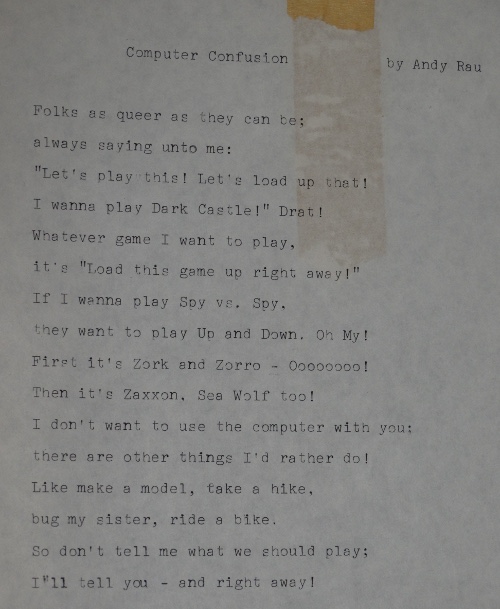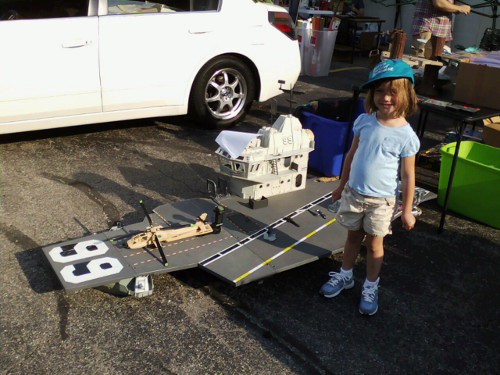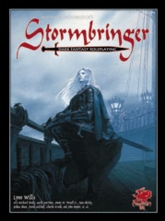This finding made it possible, three hundred years ago, to formulate a general theory of the Library and solve satisfactorily the problem which no conjecture had deciphered: the formless and chaotic nature of almost all the books. — Borges
Of the contributions made by the 2214 Nakamura-Kreitz expedition to the fields of manuscript archaeology and literary criticism, one find towers in significance above all others, and continues to cast a long shadow over the halls of academia. Much ink (along with, as survivors of the assorted semiotics conflicts of the latter 23rd century will grimly attest, actual blood) has been spilled in debating the meaning of its eight rhymed couplets.
I will not presume to add to the ongoing scholarly discussion, but with this humble essay hope to introduce a new generation of readers to one of the most puzzling manuscripts to survive the Neopacification War. The manuscript (see photograph below) was discovered in a plastic container that had been repurposed by a geneslicer mutant band to serve as part of a bunker wall. (Also in the container were five small robots of indeterminate/hybrid form; see Mullen’s Formless Masters: Optimus Prime and the Cult of Shape for a plausible, if somewhat overstated, hypothesis as to their significance).
Without further ado, the manuscript; followed by a brief set of notes on each line:

Computer Confusion by Andy Rau
Let us set aside the decades-long debate about the poem’s title and purported author’s identity and simply point out that the “confusion” cited here is not to be attributed to the computers in question (a Commodore 64 and a Mac Classic, if the rest of the poem can be trusted); but to the author and/or reader.
Folks as queer as they can be;
Steering clear of distasteful and salacious theories, I assert that everything we know about the author’s emotional maturity and understanding of gender relations at the time this poem was written suggests that this line was not intended as a sexual slur.
always saying unto me:
The unusual choice of phrasing here makes sense when one considers that Rau’s literary input at this stage of his life consisted almost entirely of The Lord of the Rings knockoffs and the Heidelberg Catechism.
“Let’s play this! Let’s load up that!”
The author here expresses frustration at the continual demands of his companions to “load up” games on his parent’s computers. While this may seem the very definition of privileged, narcissistic whining, consider that “loading up” a game from a floppy disk could take up to several minutes of the author’s precious time. (“And God help those who were ‘loading up’ from a tape drive,” Nieuwenhuizen observes in They Stayed Up Late: Concessions to Chronicity in the Lives of ‘Airborne Ranger’ Players.) See line 12ff below for a better understanding of the sacrifice Rau was being asked to make.
I wanna [sic] play Dark Castle!” Drat!
Crucially, this line provides us with a terminus post quem for “Computer Confusion”: AD 1986, the year that Dark Castle was released for the Macintosh. In 1986, Rau would have been at least eleven years of age; one shudders at the implications for his emotional maturity and social relationships were “Computer Confusion” composed much later than this date.
On the challenging presence of “Drat!” here, I cannot add to Pierce-Weyland’s groundbreaking 2314 analysis.
Whatever game I want to play,
it’s “Load this game up right away!”
Rau’s companions again pressure him to “load up” games he does not wish to play.
If I wanna [sic] play Spy vs. Spy,
they want to play Up and Down. Oh My!
Clear references to the Commodore 64 games Spy vs. Spy (1984) and Up’n Down (1983). Why Rau attempted to correct the grammar of the title Up’n Down is a mystery in light of his repeated use of the word “wanna” above.
First it’s Zork and Zorro — Oooooooo!
McCulray (2245, pp. 31-33) was the first to suggest that the frankly embarrassing Oooooooo! here is a clear sign of satirical intent; but as Franz (2247, p. 75) counters, that contrasts with the painful earnestness of the rest of the poem.
Then it’s Zaxxon, Sea Wolf too!
The selfish demands of Rau’s peers, unreasonable from the start, have at this point become unconscionable.
I don’t want to use the computer with you;
there are other things I’d rather do!
The tone of the poem sharpens uncomfortably here; Rau has been pushed to such emotional distress that he lashes out at his companions—and perhaps at the reader as well. Do we not, reading this poem hundreds of years after Rau’s “death” and assumption into the Callisto Singularity, continue to harass his memory by revisiting these baleful demands?
Sullivan (2286) asserts that in this line we see clear evidence for the Satire Theory; there is no historical evidence, he claims, that there were ever any “other things” that a youthful Rau would have prioritized over the playing of computer games. I leave it to the reader to weigh the argument.
Like make a model, take a hike,
bug my sister, ride a bike.
Although Rau reportedly took part in all of these activities, only the act of antagonizing his sibling is believed to have been preferred to playing computer games. In fact, there is some evidence that Rau was occasionally deprived of computer use privileges in parental retaliation for his constant and only occasionally provoked harassment of his sister. (Cheng’s [2293] claim that Rau’s sister “totally deserved it because she was being such a pain” is sycophantic.)
So don’t tell me what we should play;
I’ll tell you — and right away!
This bitter, challenging closing couplet has bedeviled scholars for centuries. What does Rau truly want to play? Just Spy vs. Spy? When, if ever, will he tell us? Who among us—even those who don’t subscribe to the frankly religious belief that Rau will one day return (“right away”) to name his choice of games—has not been kept awake at night by fearful mental wrestlings with the savage rejection and unfulfilled promise contained in these two lines?










 Random encounter #1: the best thing ever. When I first started GMing (with
Random encounter #1: the best thing ever. When I first started GMing (with  Random encounter #2: the worst thing ever. A few months later, the characters had been through many adventures in Middle-Earth and were coming into their own as true adventurers. One character, an elf ranger, had after much heroic toil reached 3rd level (dizzying heights of glory, from our perspective). I was growing more confident in my GMing abilities, and so when the player asked to head off on his own on a personal quest, I heartily agreed.
Random encounter #2: the worst thing ever. A few months later, the characters had been through many adventures in Middle-Earth and were coming into their own as true adventurers. One character, an elf ranger, had after much heroic toil reached 3rd level (dizzying heights of glory, from our perspective). I was growing more confident in my GMing abilities, and so when the player asked to head off on his own on a personal quest, I heartily agreed. Why did that strike me as funny? Because I think I’ve run Return to the Temple of Elemental Evil more than any other adventure campaign in my gaming career—at least three or four different times, for a different gaming group each time. And I loved it each time, as did my players. So hearing somebody describe it as “execrable” is just amusing; I’m sure they have a perfectly good reason for disliking it, but for such a horrifically bad product, it’s provided me with a heck of a lot of entertainment!
Why did that strike me as funny? Because I think I’ve run Return to the Temple of Elemental Evil more than any other adventure campaign in my gaming career—at least three or four different times, for a different gaming group each time. And I loved it each time, as did my players. So hearing somebody describe it as “execrable” is just amusing; I’m sure they have a perfectly good reason for disliking it, but for such a horrifically bad product, it’s provided me with a heck of a lot of entertainment!


